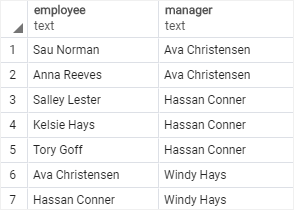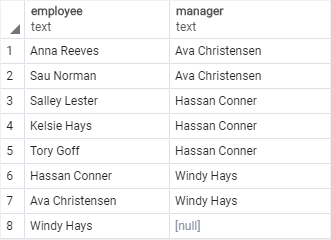August 3, 2023
Summary: in this tutorial, you will learn how to use the PostgreSQL self-join technique to compare rows within the same table.
Table of Contents
Introduction to PostgreSQL self-join
A self-join is a regular join that joins a table to itself. In practice, you typically use a self-join to query hierarchical data or to compare rows within the same table.
To form a self-join, you specify the same table twice with different table aliases and provide the join predicate after the ON keyword.
The following query uses an INNER JOIN that joins the table to itself:
SELECT select_list
FROM table_name t1
INNER JOIN table_name t2 ON join_predicate;
In this syntax, the table_name is joined to itself using the INNER JOIN clause.
Also, you can use the LEFT JOIN or RIGHT JOIN clause to join table to itself like this:
SELECT select_list
FROM table_name t1
LEFT JOIN table_name t2 ON join_predicate;
PostgreSQL self-join examples
Let’s take some examples of using self-joins.
1) Querying hierarchical data example
Let’s set up a sample table for the demonstration.
Suppose, you have the following organizational structure:

The following statements create the employee table and insert some sample data into the table.
CREATE TABLE employee (
employee_id INT PRIMARY KEY,
first_name VARCHAR (255) NOT NULL,
last_name VARCHAR (255) NOT NULL,
manager_id INT,
FOREIGN KEY (manager_id)
REFERENCES employee (employee_id)
ON DELETE CASCADE
);
INSERT INTO employee (
employee_id,
first_name,
last_name,
manager_id
)
VALUES
(1, 'Windy', 'Hays', NULL),
(2, 'Ava', 'Christensen', 1),
(3, 'Hassan', 'Conner', 1),
(4, 'Anna', 'Reeves', 2),
(5, 'Sau', 'Norman', 2),
(6, 'Kelsie', 'Hays', 3),
(7, 'Tory', 'Goff', 3),
(8, 'Salley', 'Lester', 3);
In this employee table, the manager_id column references the employee_id column. The value in the manager_id column shows the manager to whom the employee directly reports. When the value in the manager_id column is null, that employee does not report to anyone. In other words, he or she is the top manager.
The following query uses the self-join to find who reports to whom:
SELECT
e.first_name || ' ' || e.last_name employee,
m .first_name || ' ' || m .last_name manager
FROM
employee e
INNER JOIN employee m ON m .employee_id = e.manager_id
ORDER BY manager;

This query references the employees table twice, one as the employee and the other as the manager. It uses table aliases e for the employee and m for the manager.
The join predicate finds the employee/manager pair by matching values in the employee_id and manager_id columns.
Notice that the top manager does not appear on the output.
To include the top manager in the result set, you use the LEFT JOIN instead of INNER JOIN clause as shown in the following query:
SELECT
e.first_name || ' ' || e.last_name employee,
m .first_name || ' ' || m .last_name manager
FROM
employee e
LEFT JOIN employee m ON m .employee_id = e.manager_id
ORDER BY manager;

2) Comparing the rows with the same table
See the following film table from the DVD rental database:

The following query finds all pair of films that have the same length,
SELECT
f1.title,
f2.title,
f1.length
FROM
film f1
INNER JOIN film f2
ON f1.film_id <> f2.film_id AND
f1.length = f2.length;

The join predicate matches two different films (f1.film_id <> f2.film_id) that have the same length (f1.length = f2.length)
Summary
- A PostgreSQL self-join is a regular join that joins a table to itself using the
INNER JOINorLEFT JOIN. - Self-joins are very useful to query hierarchical data or to compare rows within the same table.

